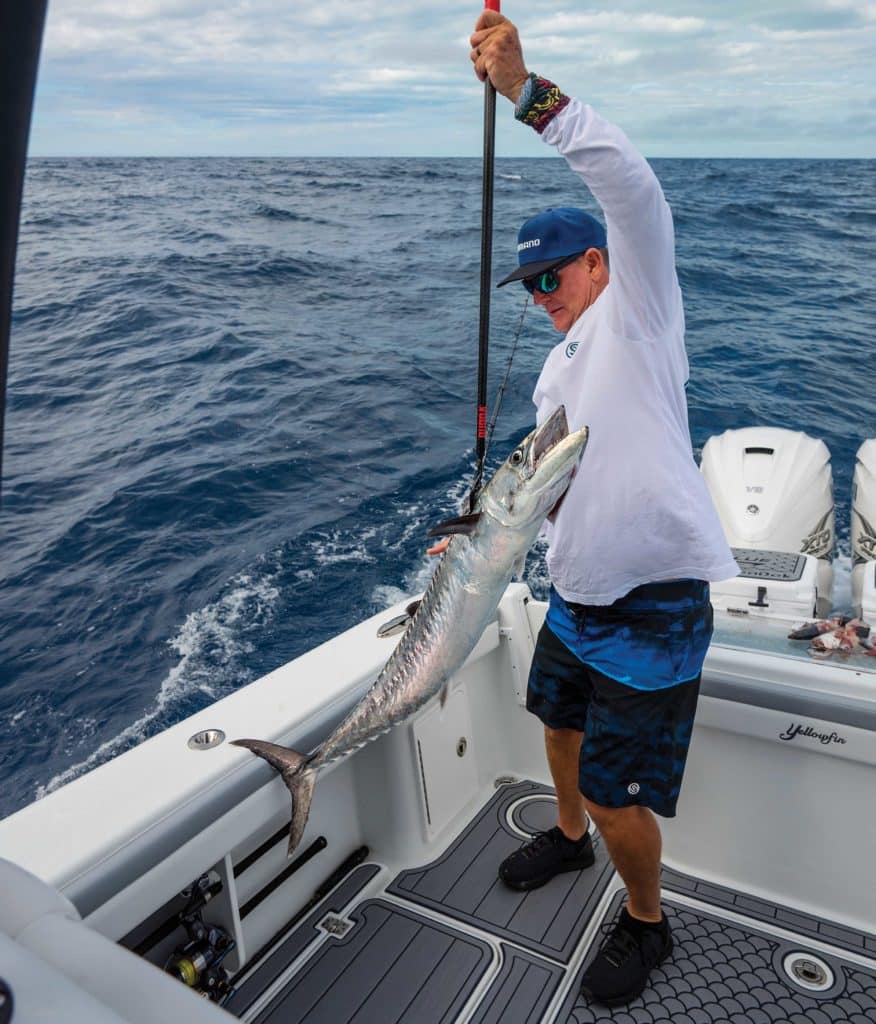
Although their methods vary, the most successful kingfish tournament pros emphasize the importance of fishing the most desirable baits in specific locations in a particular way. No detail is left to chance when it comes to catching big king mackerel.
That starts with giving kingfish something they want to eat. “What works one time of the year doesn’t always work another time,” says Capt. Ozzie Fischer of Fort Myers, Florida, who has caught two 62-pounders in Gulf of Mexico kingfish tournaments. “You can’t just have one favorite bait because kings change their feeding habits throughout the year.”
For example, he says a threadfin herring is the best kingfish bait in early spring, and a blue runner is always good. But there are times when a silver mullet will out-fish a blue runner. At other times, a ladyfish is best.
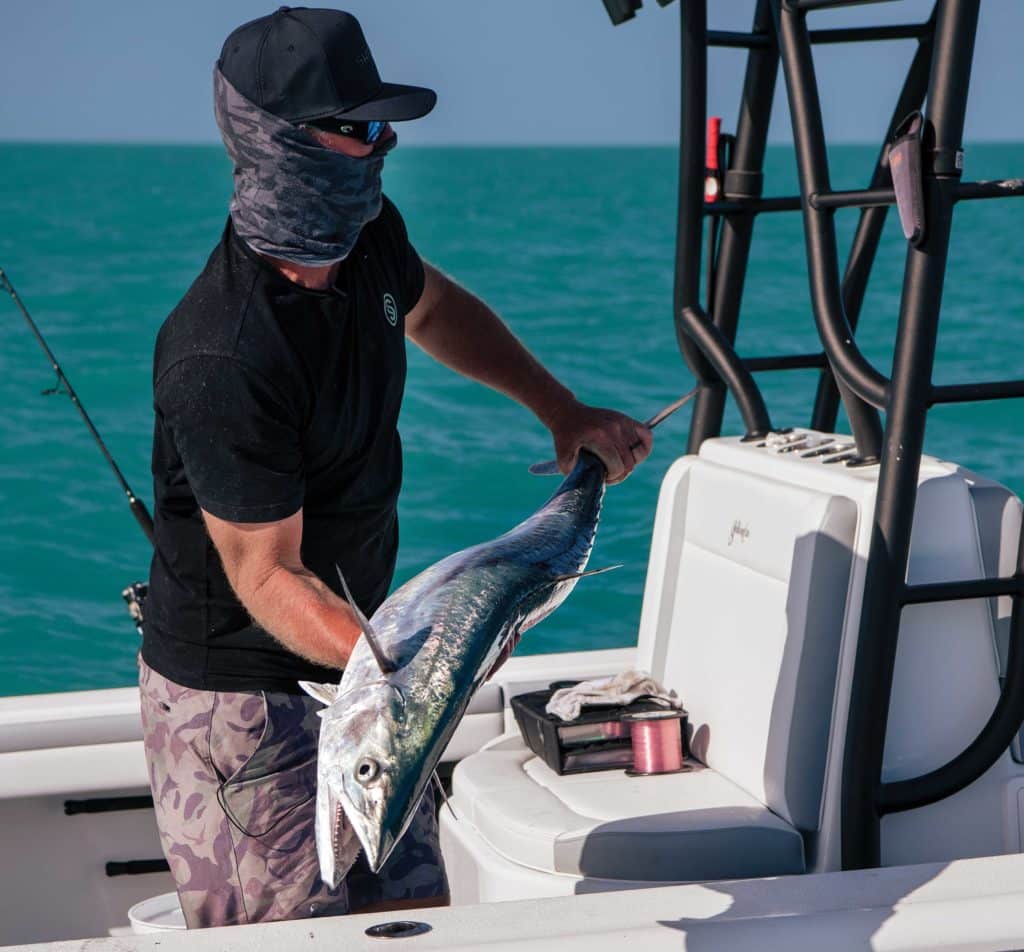
Bigger Is Better
Fischer’s go-to is a live bluefish, which he says is “the best all-around big kingfish bait there is. If I had to pick one bait to catch a giant king, it’d be a live bluefish, up to 5 or 6 pounds.”
Capt. Casey Hunt in Key West, Florida, who won numerous kingfish tourneys along Florida’s Atlantic coast before heading to the Keys, learned early on about the importance of giving kings what they want.
“For years, I ran the beach from Pompano Beach to Fort Pierce,” Hunt says. “I had speedos, I had tinker mackerel, and I had goggle-eyes. All good baits, yet I was catching smaller fish. The big kings didn’t want them. But as soon as I would catch a blue runner and put it out, we’d immediately hook a bigger kingfish because that’s what they were eating.
“Use the biggest runners you can get—3, 4, 5 pounds,” adds Hunt, who last year caught a 71-pound king off Key West on a blue runner.
For Capt. Chad Kinney in Port Mansfield, Texas, it’s hard to beat a ribbonfish for targeting big kings.
Capt. Mark Henderson out of Cape Carteret, North Carolina, who won last year’s Cape Lookout Shootout Championship thanks to a 63-pounder, puts a ribbonfish on one downrigger and a live menhaden or another bait on the other. Dead cigar minnows “are a quick and easy way to have a successful day of king mackerel fishing,” he says.
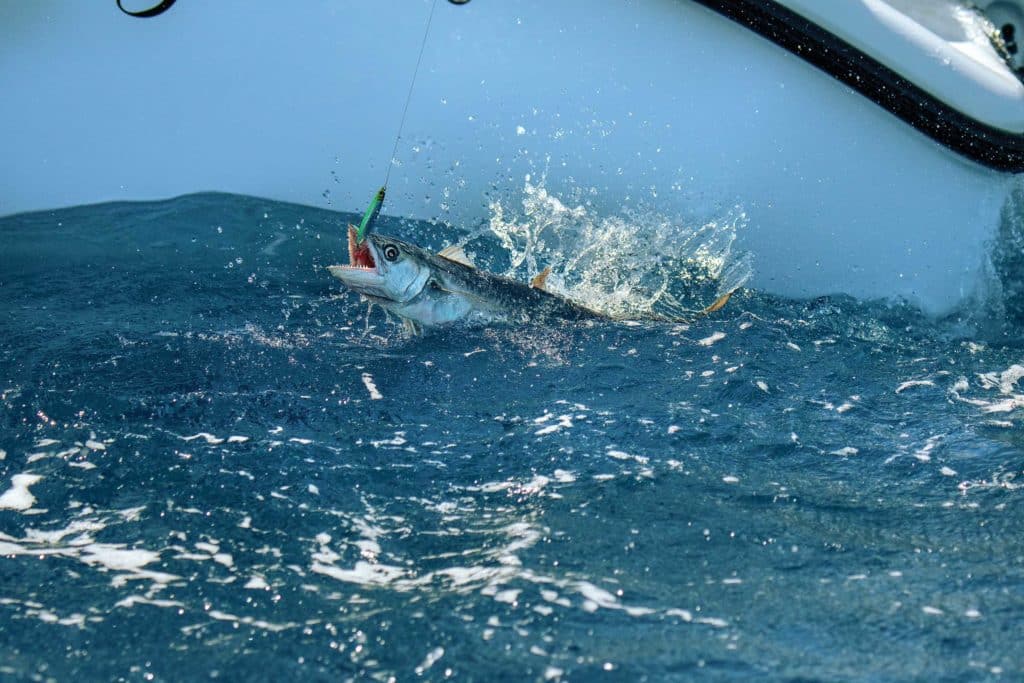
Find Fish
Anything that attracts bait also attracts kingfish. Many Gulf anglers fish oil rigs, but that can be a boat run of 8 to 50 miles.
“It depends where you’re at on the Texas coast, but what I’m looking for is structure because kings hang around structure, and I’m definitely looking for signs of bait, especially baitballs,” says Kinney, who adds that the closest rig out of Port Mansfield is 21 miles offshore. “We can run out 8 miles, and I’m in 60 to 70 feet. We have a lot of good natural structure and reefs.”
Fishing out of Key West, Hunt checks different sections of the reef that hold bait to see what’s there.
“Sometimes the current hits the reef differently and there’s bait balled up there,” says Hunt, who uses his Simrad bottom machine to find bait, and CMOR mapping to find wrecks and other structure. “Sometimes the water will get really cold, and when you find where it bumps up a little bit, even if the increase is half a degree, it can mean fish are there.”
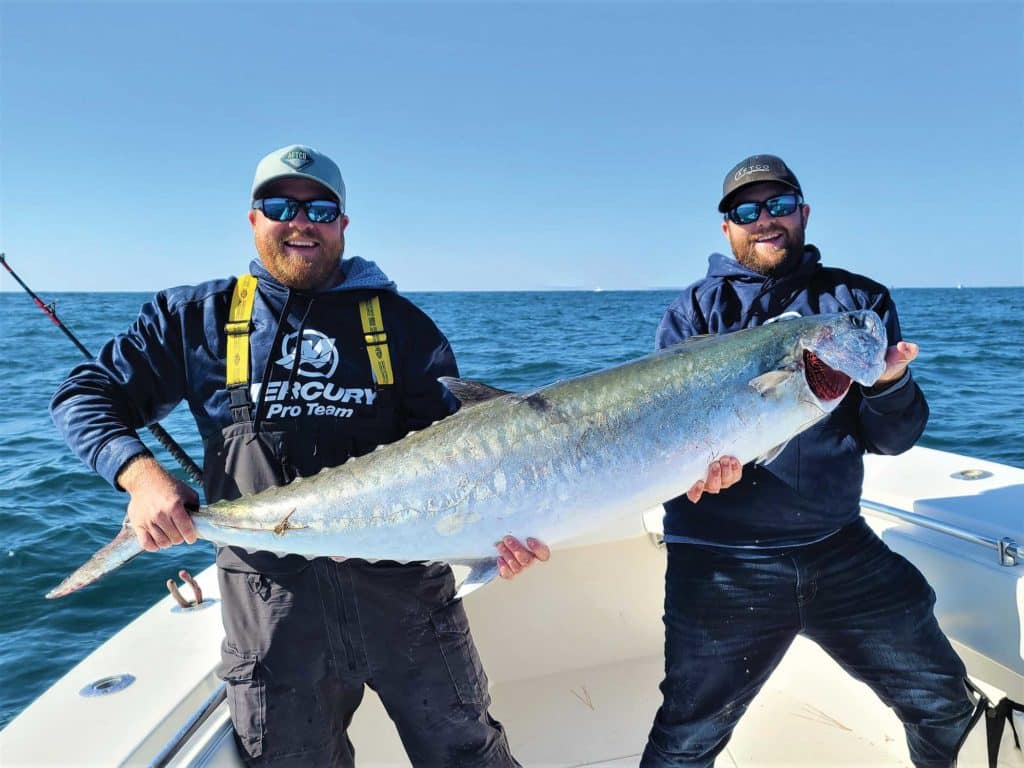
Less Is More
More lines don’t necessarily mean more kingfish, Henderson says: “Fish what your experience allows, even if it’s just two lines on opposite sides of the boat. It’s a whole lot better to fish two good ones than four that are constantly fouled up.”
Kinney has caught tournament kings up to 58 pounds while pulling only a couple of baits.
“Something I’ve done for years, even though people think I’m nuts, is trolling just two lines for kingfish. Instead of putting five out, troll two because you make tighter turns and have one staggered farther than the other one,” says Kinney, who’ll often troll a MirrOlure diving plug in addition to a ribbonfish. “If you have three or four lines out and you have a triple hookup, you’re going to lose something. You might lose your winning tournament fish.”
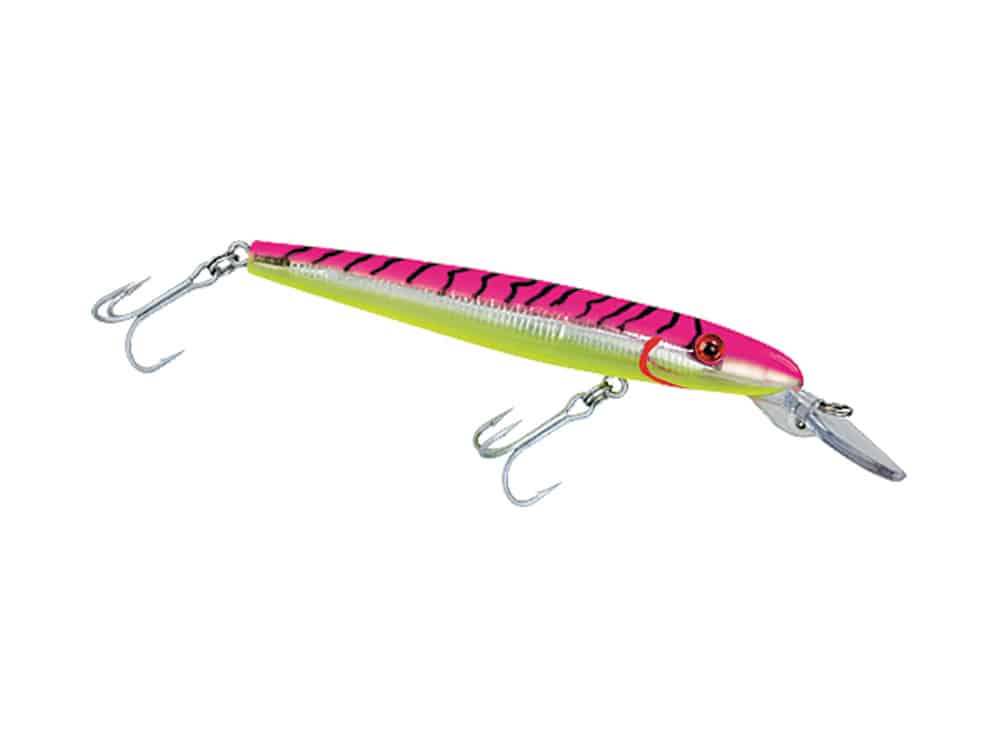
Fischer usually fishes a short line, a medium and a long. If conditions allow, he’ll also fly a kite and put out a downrigger line.
“If I have big bluefish, I’ll probably put one on my longest line, and then I’ll put a couple of blue runners out or a goggle-eye. I may change those, but I’ll leave one big bluefish out.”
Henderson fishes two downrigger lines from the transom, a shotgun bait, a medium bait, and one close from the T-top holders, plus a bait in the prop wash.
Read Next: Live Baiting and Rigging for Kingfish
“If we’re fishing live bait, we go as slow as we possibly can,” he says. “Sometimes you bump-troll, sometimes you drift a little bit. You don’t want to drag the baits through the water; you want them to swim as naturally as possible.”
Hunt takes the opposite approach, trolling live bait as quickly as possible on three lines at 30, 60 and 100 feet behind the boat.
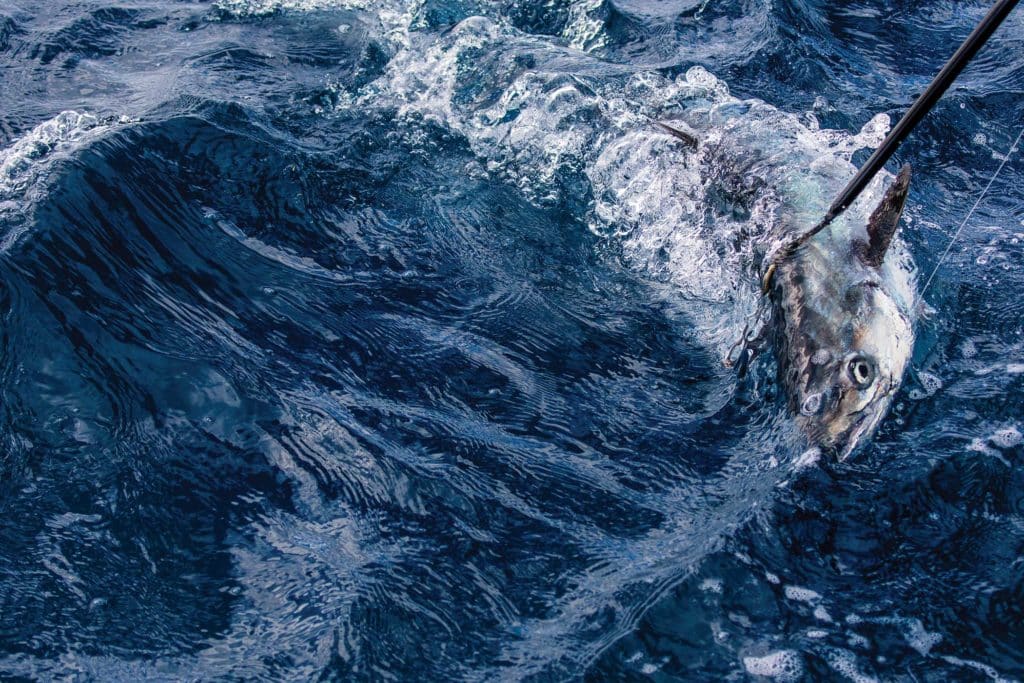
“I believe big kingfish are reaction feeders. And this is part of the reason that I fish a little bit differently than a lot of other people,” Hunt says. “I run-and-gun from spot to spot to spot, and pull my baits fast. By fast, I mean a lot of times I’ll leave both motors in gear and won’t pull them out.
“Yes, you kill a lot of bait, which means you have to change your baits often to constantly keep fresh, lively ones in the water. But by pulling these baits fast, it doesn’t give that big kingfish time enough to really examine the bait.” And that increases your chances of catching a kingfish worth bragging about.
SWS Tackle Box
Fall Kingfish
Long runs and soft mouths demand plenty of line and a smooth drag to avoid pulling the hooks on big kings. Pros prefer mono for its forgiving stretch. Wire leaders (the darker, the better) help prevent cutoffs.
- Reels: Accurate Valiant BVL 600S 20-pound conventional lever-drag reel or equivalent
- Line: 20- to 40-pound mono
- Leader: 45-pound Knot 2 Kinky nickel-titanium or similar dark-colored wire
- Bait: Catch the bait kings feed on with sabiki rigs, or use a jig for blue runners, small bonito or Spanish mackerel
SWS Planner
Off the beaches and jetties or over nearshore structure, when the kingfish are running, they will likely be available from every port on the Gulf, mid-Atlantic and Florida coasts.
- What: King mackerel
- Where: Texas, Florida and North Carolina
- When: August through October
Port Mansfield, Texas
Capt. Chad Kinney
956-802-2269, bammbammfishing.com
Key West, Florida
Capt. Casey Hunt
305-849-4242, cnitadventures.com
Captiva Island, Florida
Capt. Ozzie Fischer
239-777-7500, fischercharters.com
Cape Carteret, North Carolina
Capt. Mark Henderson
252-723-1113, liquidfiresportfishing.com









